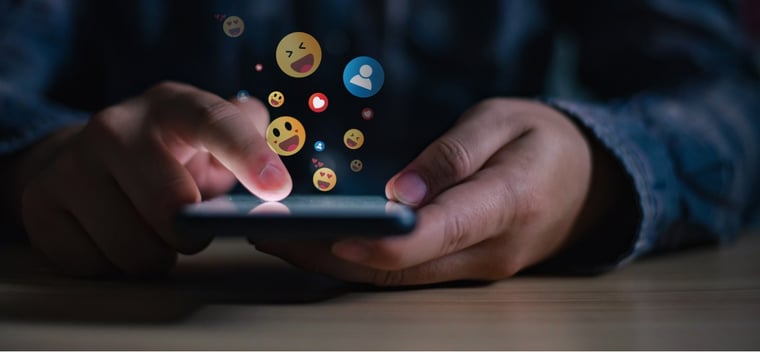
The world’s fastest-growing language is Emoji. In fact, 90% of the world’s online population uses them. Ignore the language of Emoji, or don’t plan for it, at your peril. 😬
These are not just little symbols we send each other for personal reasons anymore. It’s now totally acceptable to use them in the business world to convey feelings. To humanize ourselves as all forms of online communications – from emails to messages to texts – become less formal.
So how do you address them from a translation point of view? At LinguaLinx, as a Language Services Provider (LSP), we help clients who are localizing into new markets and need to understand the implications of using emojis across languages.
Surely, they’re just little pictures, right? Aren’t they international and don’t need translation? Unfortunately, it’s not that simple, but don’t worry…you can do it. 🙂
In this article, we’ll look at the four main things you need to consider when translating emojis into another language.
Top 4 Considerations for Translating Emojis
1. How Are You Going To Use Emojis? Keep It Simple
Is it marketing content? Probably, right? Let’s face it, emojis are taking over when brands want to hit the younger zeitgeist with disposable money and a TikTok generation attention span. It’s unlikely you’re writing legal contracts, creating health and safety training, or developing technical manuals using emojis.
Emojis lend themselves to marketing spaces that are fast-moving and scannable. So, keep your use of emojis simple. Enough that you’re getting the message across, but not too much that you have a compound effect, and one emoji affects the next. This is where translation issues can also multiply.
An example of this can be found in a study covered by the UK’s Daily Mail newspaper. They found that the emoji combo 😷💪 ,which represents sickness and getting better, was interpreted by French Canadians as “bicep implants” and by Arabic translators as “my armpits are smelly.”
2. What Platform Are You Using?
Are you messaging with an iPhone or iPad, or are you using a Google Pixel tablet? It makes a difference.
It might well be that your translated message is going to be seen by a wide audience, maybe it’s advertising, and you can’t control what devices will be picking up the communication. In this case, just consider if you can reduce your use of emojis, especially ones that carry the most ambiguity.
GroupLens Research and the University of Minnesota did extensive research into which emojis are most likely to be misinterpreted. 🙌 struggled, while most people agreed on what 😍 meant.
3. What Software Are You Using?
Using emojis in translations that don’t have post-editing factored in is very risky. Some translation software doesn’t recognize emoji characters. They simply put placeholders in when the translation comes across an emoji. If this goes unchecked, then that placeholder will be seen by the target person (or thousands of people), which could appear confusing, inaccurate, lazy, or all three.
As with all translations, your LSP should have a good Quality Assurance (QA) process that will run tests and eliminate these kinds of issues. Still, it’s worth knowing that they exist as it might inform the original text you’re translating.
4. Not All Emojis Mean The Same Thing In Every Language
Double check what the emojis you’re using mean in other languages. You might be quite surprised.
The BBC found that the following examples of how emojis are seen very differently in certain cultures:
-
🙂 in China, this equals distrust, disbelief, or even that someone is humoring you.
-
😇 rather than saying you’ve done something saint-worthy, in China, the angel emoji represents death and may be perceived as threatening.
-
👏 again, a difference of opinion occurs in China, where clapping hands means making love.
-
👍 in Greece and the Middle East, giving a thumbs up is traditionally interpreted as vulgar and offensive in person and in emoji.
-
💩 in Japan, this is a wish for someone to have good luck.
-
🤘 in Latin countries like Brazil, Spain, Cuba, and Uruguay, this can refer to “wearing horns,” a metaphor for adultery.
-
👌 in Brazil and Turkey, this “ok” symbol is the equivalent of giving the middle finger in the US. Definitely not ok.
Emojis are The Future of Communication
So even if it’s not World Emoji Day (yep…July 17th), you’ve got to consider these little guys in your translation or localization strategy. You’d do the same with any imagery you use, so this shouldn’t be too hard as long as you’re partnering with a good LSP. And run a mile from any LSP that tries to steer you clear of emojis. This is your brand, you know how to communicate with your audience, and emojis can boost engagement levels and click-through rates. BUT simplify, simplify, simplify.
It comes down to being cognizant of your translation process and software, understanding that emojis can mean different things in different cultures, and making sure they’re part of the conversation.
Get A Quote For Your Translation Project
Translating emojis requires thoughtful consideration to ensure they convey the right message across different cultures and platforms. From how emojis are interpreted to the software you use, every detail matters in avoiding miscommunication.
LinguaLinx is here to guide you through the process. With ISO 17100 and ISO 9001 certifications and over two decades of experience, we ensure your translations are accurate, culturally sensitive, and seamless—whether or not emojis are part of your message.
Reach out today for a free, no-obligation consultation. Let LinguaLinx be your trusted partner in delivering clear, effective communication to global audiences.



.jpg?width=450&height=250&name=Translation%20in%20Travel%20and%20Tourism%20(1).jpg)


